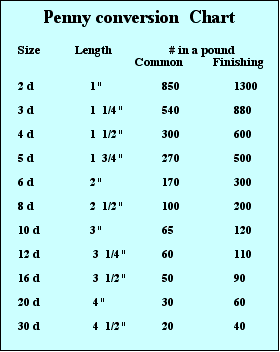"Helping woodworkers online for over 20 years"
| Nails are something that we take for granted in this age of plenty that we live in, I remember my grandad sitting in the shop spending a rainy afternoon straightening used rusty nails some sixty years ago. He said we were lucky to have pails full of nails and would recount how at one time, when nails were made by hand, buildings would be purchased and demolished just to acquire the nails. |  |
About Nails 101
With modern manufacturing methods nails are a very minor factor in the cost of building a project, the only carry over from the old days is the "penny nail" size definition, which was the price per one hundred nails in the 15th century. This is abbreviated to "d", from the Roman coin Denarius, hence plans call for 3d nails ( pronounced 3 penny). Below is a chart giving the length in inches, and aproximate number per pound of the most common sizes.
To convert sizes up to 10 d, take the length you want, subtract 1/2", then multipy by 4. For example a 2 1/2" long nail would work out to 2 1/2" - 1/2" is 2 X 4 equals 8 d, conversely divide size by four and add 1/2, so 6d diveded by 4 is 1 1/2 plus 1/2 = 2" Types of Nails Casing |

